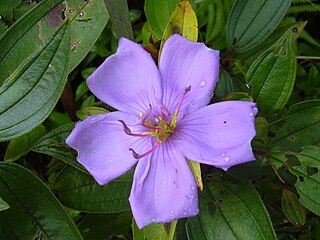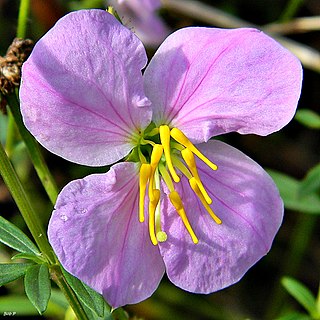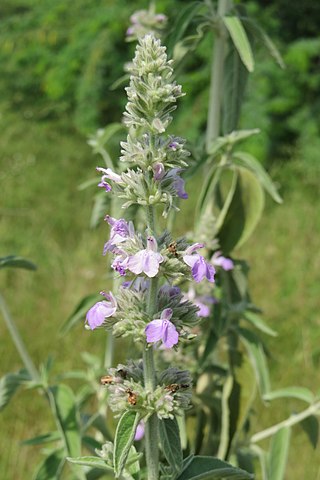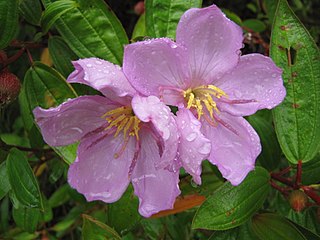
The Clusiaceae or GuttiferaeJuss. (1789) are a family of plants including 13 genera and ca 750 species. Several former members of Clusiacae are now placed in Calophyllaceae and Hypericaceae. They are mostly trees and shrubs, with milky sap and fruits or capsules for seeds. The family is primarily tropical. More so than many plant families, it shows large variation in plant morphology. According to the APG III, this family belongs to the order Malpighiales.

Buzz pollination or sonication is a technique used by some bees, such as solitary bees and bumblebees, to release pollen which is more or less firmly held by the anthers. The anthers of buzz-pollinated plant species are typically tubular, with an opening at only one end, and the pollen inside is smooth-grained and firmly attached. With self-fertile plants such as tomatoes, wind may be sufficient to shake loose the pollen through pores in the anther and accomplish pollination. Visits by bees may also shake loose some pollen, but more efficient pollination of those plants is accomplished by a few insect species who specialize in sonication or buzz pollination.

Melastoma is a genus in the family Melastomataceae. It has over 100 species distributed around Southeast Asia, India, north to Japan, south to Australia and the Pacific Islands. The number of species should probably be reduced according to some sources. Many species have been planted around the world for the aesthetic value of their bright purple flowers.

Rhexia is a genus of flowering plants in the family Melastomataceae. Rhexia species are commonly called "meadow beauty" and 11 to 13 species of Rhexia have been recognized depending on different taxonomic treatments.

Dampiera purpurea, commonly known as the mountain- or purple dampiera, is a subshrub in the family Goodeniaceae native to Victoria, New South Wales and Queensland in eastern Australia. Its blue-purple flowers appear in spring and early summer, and it is pollinated by insects such as butterflies and bees. Adapting readily to cultivation, Dampiera purpurea is grown as a garden plant in Australia.
Melastoma denticulatum is a species of flowering plant in the family Melastomataceae, native from the Solomon Islands to the south Pacific.

Xylocopa bombylans, the peacock carpenter bee, is a species of carpenter bee found in Australia. It gets its common name by its habit of burrowing into wood.

Persoonia lanceolata, commonly known as lance-leaf geebung, is a shrub native to New South Wales in eastern Australia. It reaches 3 m (10 ft) in height and has smooth grey bark and bright green foliage. Its small yellow flowers grow on racemes and appear in the austral summer and autumn, followed by green fleshy fruits which ripen the following spring. Within the genus Persoonia, P. lanceolata belongs to the lanceolata group of 58 closely related species. It interbreeds with several other species found in its range.

Anisomeles malabarica, more commonly known as the Malabar catmint, is a species of herbaceous shrub in the family Lamiaceae. It is native to tropical and subtropical regions of India, and Sri Lanka, but can also be found in Malaysia, Bangladesh, Myanmar, Bismarck Archipelago, Mauritius, Andaman Islands and Réunion.

Melastoma malabathricum, known also as Malabar melastome, Indian rhododendron, Singapore rhododendron, planter's rhododendron and senduduk, is a flowering plant in the family Melastomataceae native to Seychelles, tropical and subtropical Asia to Australia and western Pacific islands. Despite its common names, it does not have any connection to actual rhododendrons, and belongs to the Rosids clade as opposed to the Asterids clade. This plant is usually found at elevations between 100 m and 2,800 m in grassland and sparse forest habitats. It has been used as a medicinal plant in certain parts of the world, but has been declared a noxious weed in the United States. M. malabathricum is a known hyperaccumulator of aluminium, and as such can be used for phytoremediation.

Persoonia terminalis, also known as the Torrington geebung, is a shrub belonging to the family Proteaceae, and native to northern New South Wales and southern Queensland in eastern Australia. Reported as a subspecies of Persoonia nutans in 1981, it was described as a species by Lawrie Johnson and his colleague Peter Weston in 1991.

Melastoma septemnervium are erect shrubs or small slender trees with 5 petal, medium-sized, pink flowers that have made them attractive for cultivation. The leaves have the 5 distinctive longitudinal veins (nerves) typical of plants in the family Melastomataceae.
Axinaea affinis is a species of tree in the family Melastomataceae. It is native to mountainous regions of the Andes in South America in Peru and Ecuador. Its natural habitat is subtropical or tropical moist montane forests.

Pimelea pagophila, commonly known as Grampians rice-flower, is a species of shrub in the family Thymelaeaceae. It has a restricted distribution, white flowers in spherical heads at the end of branches, green leaves arranged in opposite pairs and is endemic to Victoria, Australia.

Pimelea aeruginosa is a species of small shrub in the family Thymelaeaceae. It is a small shrub with yellow flowers and is endemic to Western Australia.

Pimelea ammocharis is a species of small shrub in the family Thymelaeaceae. It is a small shrub with white-yellow to orange flowers and is endemic to Western Australia.

Andesanthus lepidotus, synonym Tibouchina lepidota, also known as alstonville, Andean princess flower, lasiandra, or glory bush, is a medium-sized ornamental tree or a large shrub native to northwestern South America that is cultivated for its masses of purple flowers from autumn right through to winter.
Memecylon caeruleum is a shrub or tree species in the Melastomataceae family. It is found from New Guinea, west through Southeast Asia to Tibet, Zhōngguó/China. It has become an invasive weed in the Seychelles. It has some local use for wood and food.
Pternandra is a genus of trees in the Melastomataceae family. There are 17 species in the taxa. It is native to an area from northern Australia through Southeast Asia to Hainan, Zhōngguó/China and India. The botanist William Jack who named the taxa, died at 27 years of age, the year his description was published.

Pollen theft, also known as pollen robbery or floral larceny, occurs when an animal actively eats or collects pollen from a plant species but provides little or no pollination in return. Pollen theft was named as a concept at least as early as the 1980, and examples have been documented well before that. For example, native honey bees were documented 'stealing' large amounts of pollen from the large, bat-pollinated flowers of Parkia clappertoniana in Ghana in the 1950s. Nevertheless, pollen theft has typically received far less research attention than nectar robbing, despite the more direct consequences on plant reproduction.

















